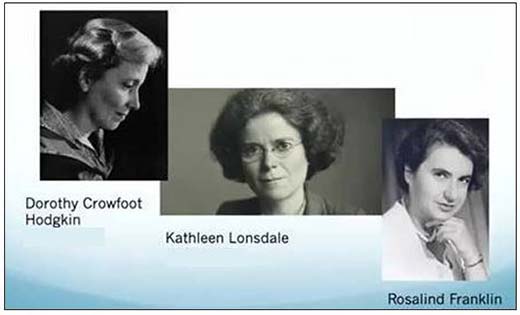Tuesday, 30 March 2021
From Diamonds to DNA – Stories of Three World-Changing Women Scientists
Speaker: Georgina Ferry
Todmorden u3a welcomed Georgina Ferry by zoom on Thursday 18th March to their monthly members' meeting, where she told a tale of three ground-breaking women scientists of the twentieth century.

When Kathleen Lonsdale got the top mark in physics in the whole of the University of London in 1922, Sir William Bragg promptly invited her to join his newly formed team who were to use the novel technique of x-ray crystallography in his laboratory.
Kathleen was particularly interested in looking at molecules that occur in living bodies, all of which have carbon within them. These organic molecules can be arranged in a myriad of ways, and crystallography promised help in deducing the molecular structure. In 1929, she showed that the benzene molecule was a flat six-membered ring by using X-ray diffraction, a major step forward at the time.
Marrying in 1927, she had three children and a battle to balance her work and home life. William Bragg valued her so highly that he persuaded Sir Thomas Mond of ICI to sponsor her by funding help at home, and allowing her to continue to work on substances like diamond and Lonsdaleite (named after her).
In her private life she was an immensely moral woman and was, with her husband, a Quaker, so when World War II broke out she refused to register for war work and was subsequently imprisoned. This experienced caused her to actively pursue prison reform after the war. She died in London on 1 April 1971 of cancer.
Georgina's second scientist was Dorothy Crowfoot who went to Somerville College at Oxford University, matriculating in 1928. She learnt the elements of crystallography in her last year at Oxford and after her PhD at Cambridge, she joined the laboratory of J D Bernal, who had also worked with William Bragg at the Royal Institution. Together they took the first x-ray photograph of a crystallised protein, pepsin, which is a digestive enzyme.
In 1934 Dorothy started working on insulin, but it was a very difficult problem to solve, so she also worked with penicillin. She solved the structure of penicillin by 1945 and in 1947 she was elected a fellow of the Royal Society. In the meantime she had married Thomas Hodgkin in 1937 and subsequently had three children.
Dorothy proceeded to work on vitamin B12, which prevents pernicious anaemia, and it was for her work on penicillin and B12 that she was awarded the Nobel Prize in 1964. In the following year she was admitted to the Order of Merit, the first woman since Florence Nightingale. In 1960, Hodgkin was appointed the Royal Society's Wolfson Research Professor and went on to eventually solve the structure of insulin in 1969, thirty-five years after starting out.
Finally, possibly the most well-known of the three women, Rosalind Franklin studied chemistry at Cambridge and was working at Kings College London when Crick and Watson were trying to work out the structure of DNA. Unbeknown to Crick and Watson, Rosalind had X-rayed and photographed a DNA crystal but it only came to light after she left. Rosalind was unhappy at Kings and went to work with Bernal at Birkbeck College, London. Before she left she gave the photo of DNA to a colleague, Maurice Wilkins, who passed it on to James Watson who showed it to Crick, and they built the famous double-helix model of DNA based upon it.
When they published the work in Nature, they made no reference to Rosalind's contribution, only to say later, as Nobel Prize winners, that they were vaguely aware of some work going on Kings. Rosalind's work was never recognised in her lifetime. Eventually James Watson wrote a book in 1968 entitled 'The Double Helix' in which he referred to Rosalind's work.
At Birkbeck she continued by working on viruses, in particular the tobacco mosaic virus, taking some ground breaking photographs, which were turned in to molecular models exhibited at the Brussels World Fair. Sadly, she died of cancer before she could visit the exhibition and see the celebration of her work.
Georgina said that all these women exhibited not only great scientific knowledge but determination to get the job done. Time just seemed to fly by with this thoroughly engaging talk, and the session was concluded with thoughtful questions from the estimated 75 members in the meeting.
The next Todmorden U3A Monthly Members Meeting by Zoom will be on Thursday 15th April 2021 at 1.45 p.m., open to all fully paid-up members.
Our presenter for April will be Dr. Lizzie Collingham with a talk entitled, ''The Biscuit – A History of a Very British Indulgence''.
Our contact details are www.u3atod.org.uk (website), info@u3atod.org.uk (email), or 01422 886021 (phone).
Many thanks to Michael Astrop for this report
Previous U3A reports on the HebWeb - click here

